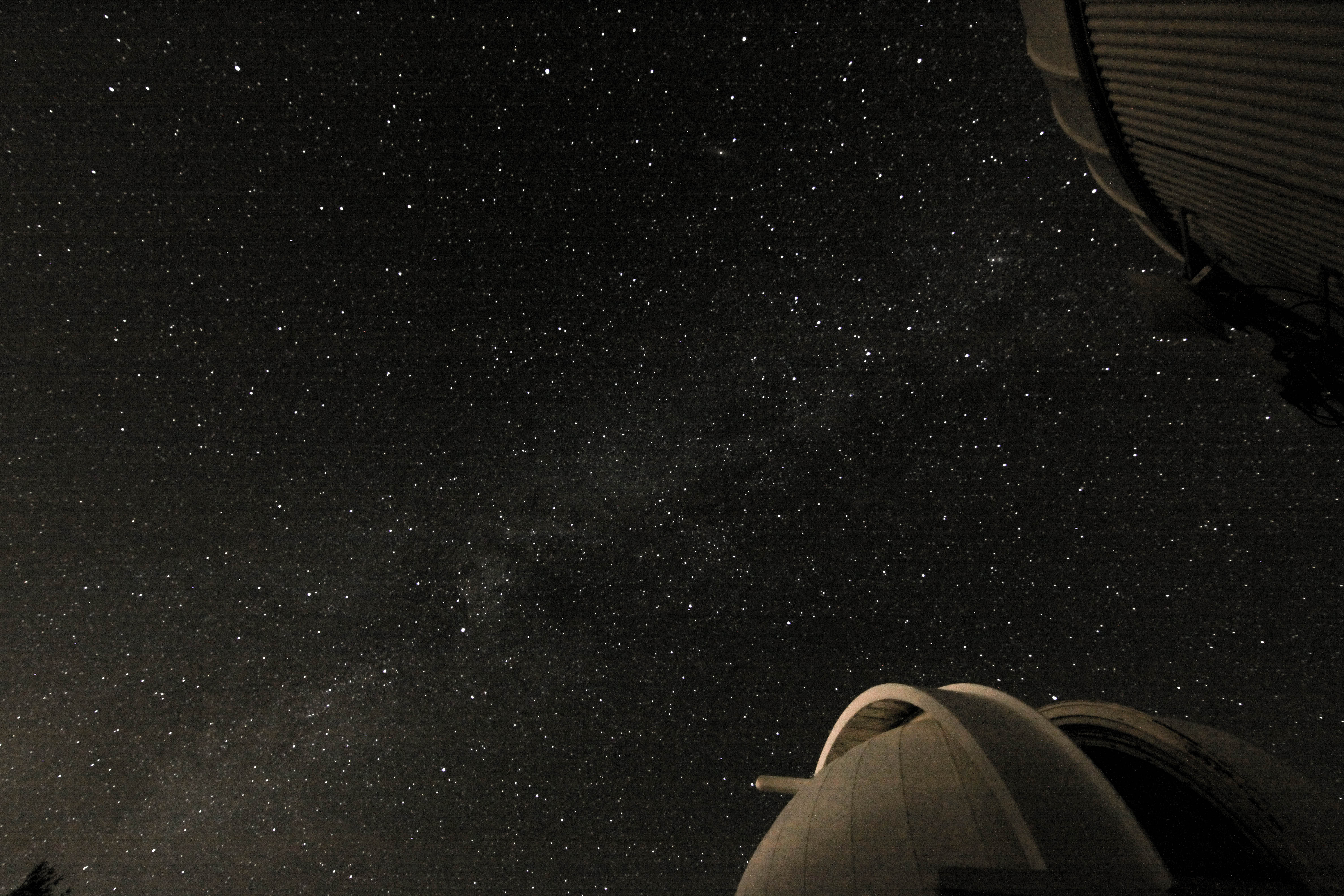Facilities
CSS Telescopes
The Catalina Sky Survey (CSS) telescopes are located in the Santa Catalina Mountains just north of Tucson, Arizona. CSS utilizes three telescopes owned and managed by Steward Observatory of the University of Arizona. The 1.5-meter Cassegrain reflector (MPC observatory code = G96) is located on the 9,157-foot summit of Mt. Lemmon, along-side the 1.0-meter reflector. The 1.0-meter (MPC observatory code = I52) is used to support a variety of NEO follow-up and is remotely operated in a queue-scheduled mode, but also dynamically handles same-night follow-up requests from the CSS survey telescopes. The 0.7-meter Schmidt telescope (MPC observatory code = 703) is located on Mt. Bigelow, just east of Mt. Lemmon. These telescopes and detectors are further described here:
1.5-meter Telescope: The 1.5-m survey telescope is an f/1.6 reflector equipped with a 111-megapixel (10,560 x 10,560 pixel) CCD detector mounted at prime focus. The field of view is 5.0 deg2 with a pixel scale of 0.77”/pixel (unbinned). Covering 1000 square degrees per night with a limiting magnitude V~21.5 images are obtained using a 2 x 2 binning mode with an exposure time of 30s.
The Mt Lemmon Station 1.5-m reflector telescope: At bottom left: The 60-inch surveying under moonlit skies, Top left: observer Greg Leonard at the business end of the new 10k x 10k camera, Center: In twilight, G96 stands ready for surveying, Top right: multiple lens elements beneath the camera, Bottom right: Each night begins with the promise of new discoveries.
1.0-meter Telescope: The 1.0-m follow-up telescope is an f/2.6 Cassegrain reflector equipped with a 2k x 2k CCD detector. The field of view is 0.3 deg2 with a pixel scale of 1.03”. This telescope typically recovers 40-80 targeted NEOs per night with a limiting magnitude V~ 22.0.
The 1m (40 inch) reflector is primarily used for follow-up of NEOs and is operated remotely from CSS Operations Center on the University of Arizona campus..
0.7-meter Telescope: The 0.7-m survey telescope is an f/1.8 Schmidt catadioptric equipped with a 111-megapixel (10,560 x 10,560 pixel) CCD detector mounted at prime focus. The field of view is 19.4 deg2 with a pixel scale of 1.5” (unbinned). Covering 4000 square degrees per night with a limiting magnitude V~19.5 images are obtained using an exposure time of 30s.
The Mt Bigelow Station 0.7m Schmidt telescope: At left: The Schmidt open for business under starry skies, as an Iridium flare streaks overhead, Center: Surveying the skies, Top right: Schmidt corrector plate, sans baffle, Bottom right: Winter day on Mt Bigelow.
The 61" Kuiper telescope and the CSS Schmidt under starry skies at Mt Bigelow Station.
Remote Observing Lab
Catalina Sky Survey’s Operation Center (aka Remote Observing Lab), located in the Lunar and Planetary Lab building was established to facilitate remote observation of NEOs using the 1-m (40 inch) Cassegrain reflector located atop Mt Lemmon. Unlike CSS’s survey telescopes, the 1-m is dedicated to following up recently discovered NEOs with new observations in effort to extend the orbital arcs for the objects to constrain and improve orbital determination. Observers also systematically target NEOs discovered over past years, again to refine their orbits for objects that will eventually receive permanent numbered status with the Minor Planet Center, indicating the highest level of orbital accuracy and precision. Operationally, remote observing with the 1-m is semi-automated. Objects targeted for follow-up observation are submitted into a custom queue manager which calculates and informs the telescope control system how to most efficiently move from object to object. The observer can primarily focus on validation of the targeted objects.
View of theRemote Observing Lab control center.
Instrument Lab
CSS maintains an instrument and hardware lab with and benches for testing new hardware, troubleshooting and repair.
Beginning in 2016 CSS was funded to create a publicly accessible archive of asteroid survey data products acquired since the 2003/2004 observing season. This amounts to ~40 telescope years of data from the observatories in Arizona and Australia, about 3,000,000 images total plus many millions of related files of catalog and astrometric information. Catalina has partnered with the Small Bodies Node of the Planetary Data System (PDS), hosted at the Planetary Science Institute (PSI) in Tucson, to work toward this goal. We anticipate the initial project will take about three to four years.
The initial work has focused on safeguarding Catalina's precious data by completing an inventory of CSS data and replicating the archive holdings onto new duplicate mass storage systems hosted at two locations on the University of Arizona campus: 1) CSS headquarters at the Lunar and Planetary Laboratory, and 2) co-located at the high bandwidth and highly redundant 24/7 University Information Technology Services (UITS) data center. In the initial year of the project storage and servers were acquired, configured, and installed at both locations, with all CSS servers at LPL being moved into a new climate and power controlled computer room. All CSS archival data were replicated onto both sites, and at the same time the CSS hard media (DVDs and Blu-ray disks) were moved into climate controlled quarters for deep storage.

Catalina Sky Survey data archive facilities, including a) and b): LPL-based storage and servers and c): DVD and Blu-ray hard media all located within a dedicated power- and climate-controlled room; and d) redundant CSS mass storage located within the University Information Technology Services (UITS) data center.
CSS and PSI are iterating on plans to begin ingesting nightly data sets into the PDS toward the end of 2017. This requires describing the complex CSS data products and metadata in terms understandable to PDS. Catalina will also take this opportunity to reprocess legacy data sets through the current CSS pipeline workflow, and batch reprocessing of the millions of files will commence after nightly archiving is fully commissioned. We anticipate that this will also produce numerous prediscovery observations of catalog objects that have since become known, which will be submitted to the Minor Planet Center to extend orbital arcs.








